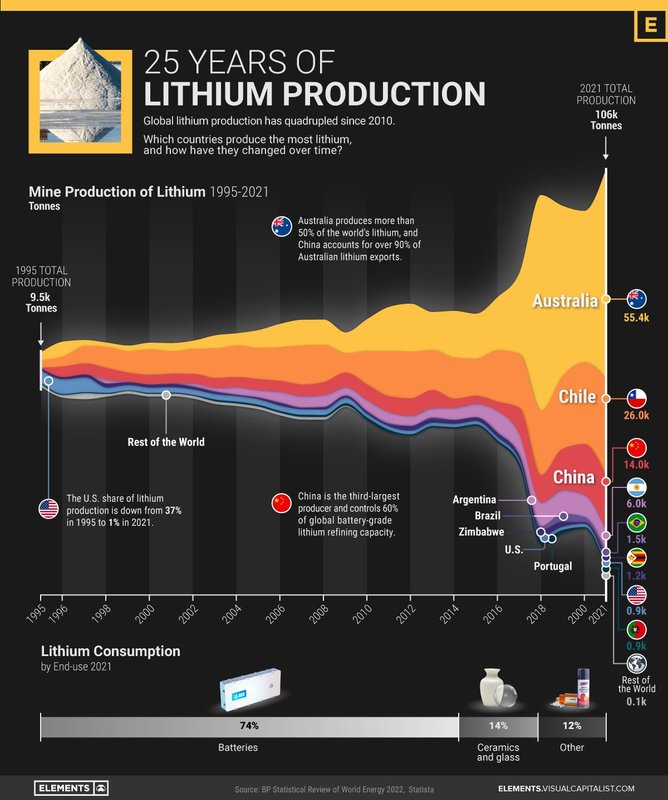Focus on: Lithium – ‘White Gold’ Driving the EV Revolution

This is the first in a series of snapshot-style features looking at the world’s most mined metals and minerals …
What is Lithium?
Lithium – (from the Greek ‘líthos’, meaning 'stone' is a chemical element (Li), and is a soft, silvery-white alkali metal. It is the least dense metal and the least dense solid element. Like all alkali metals – including sodium and potassium – lithium is highly reactive and flammable, and must be stored in vacuum, or in an inert liquid, such as purified kerosene or mineral oil.
How is lithium obtained?
DLE Direct lithium extraction (DLE) technology sees brine pumped into a processing unit where a resin or adsorption material is used to extract only the lithium from the brine. (Adsorption is the process by which a solid holds molecules of a gas or liquid as a thin film.) DLE technology offers higher recoveries and purities than other forms of lithium extraction.
Evaporation Lithium is highly soluble, and as a result is present in sea water, which is why it is commonly obtained from brines. The traditional way to extract lithium from brine is through evaporation ponds.
There are environmental concerns over this method, with concerns that it harms the soil and causes air contamination.
Hard-rock extraction Lithium extracted by ‘hard-rock’ comes from minerals hosted in Pegmatites. A pegmatite is a crystalline igneous rock similar to granite, and usually formed of quartz, feldspar, and mica.
The hard-rock method extracts lithium directly from pegmatites, using surface mining techniques. It is then processed into lithium hydroxide, the compound preferred by EV battery manufacturers.
What is lithium used for?
Batteries The most important use of lithium is for rechargeable batteries for mobile phones, laptops, digital cameras and, crucially, EVs.
Without lithium, the global bid to move away from the internal combustion engine to electric vehicles (EVs) is doomed.
According to the World Economic Forum, each individual EV battery requires around 8kg of lithium.
Alloys Lithium is made into alloys, being combined both with aluminium and magnesium for strength and lightness. Magnesium-lithium alloy is used for armour plating, while aluminium-lithium alloys are used in aircraft, bicycle frames and high-speed trains.
Glass Lithium oxide is used in specialty glasses and glass ceramics.
Dehumidification Lithium chloride is one of the most hygroscopic (absorbant) materials known, and is used in air conditioning and industrial drying systems, as is lithium bromide.
Lubricants Lithium stearate is used as an all-purpose and high-temperature lubricant.
Medicines Lithium carbonate is a mood stabilising medicine used to treat bipolar disorder, although how it works on the brain is not fully understood.
How much Lithium is mined annually?
Worldwide lithium production in 2022 increased year on year by 23%, to approximately 130,000 tonnes. This was in response to strong demand from the lithium-ion battery market, which also increased the price of lithium, encouraging greater production.
Every 100,000 metric tonnes of lithium is enough to manufacture an estimated 12,500,000 EV batteries.
Which countries produce the most Lithium?
Global lithium production surpassed 100,000 tonnes for the first time in 2021, quadrupling from 2010, with demand driven by lithium’s importance to battery technology. A total of 90% of the world’s lithium production comes from just three countries:
- Australia (52%)
- Chile (25%)
- China (13%)
In the 1990s, the US was the world’s largest producer of lithium, but now accounts for just 1% of global production.
Australia is home to the world's largest hard-rock lithium mine. The Greenbushes lithium mine is an open-pit mining operation in Western Australia, and produces around 1.95mn tonnes of lithium spodumene annually. (Spodumene is a mineral consisting of lithium aluminium inosilicate, a commercially important source of lithium.)
Lithium output in Chile is derived from brines, which are pumped from below the earth's surface into evaporation ponds in the Atacama Desert.
China has more than half of the world's lithium refining capacity, but relies on imports for about two-thirds of the raw material, according to a recent study by the Institute of Energy Research. Mostly this comes from Australia, Africa, Chile, Argentina and Bolivia.

Who are the biggest lithium mining companies?
1. Jiangxi Ganfeng Lithium Company Based in China, Jiangxi Ganfeng is the largest lithium metal producer in the world. Its lithium compound capacity ranks third worldwide and first in China. It holds lithium resources across Australia, Argentina, and Mexico. In 2023 it reported revenues of US$7.5bn.
2. Albemarle US-based Albermarle was founded in 1994, and is the second-largest lithium miner in the world. It has three divisions: lithium, bromine specialties, and catalysts. The company has over 5,000 employees in 100 countries, As of 2020, it the largest provider of lithium for EV batteries.
3. Tianqi Lithium Another Chinese giant, Tianqi is the world’s largest hard-rock lithium producer, and holds resource and production assets across Australia, Chile, and China. It has 1,800 employees globally.
- Supply Chain in Mining: The Race for Critical Raw MaterialsSupply Chain & Operations
- Geothermal Engineering - UK’s first zero-carbon lithiumSustainability
- Chile to nationalise lithium industrySupply Chain & Operations
- Rockwell Automation supports sustainable lithium productionSustainability
